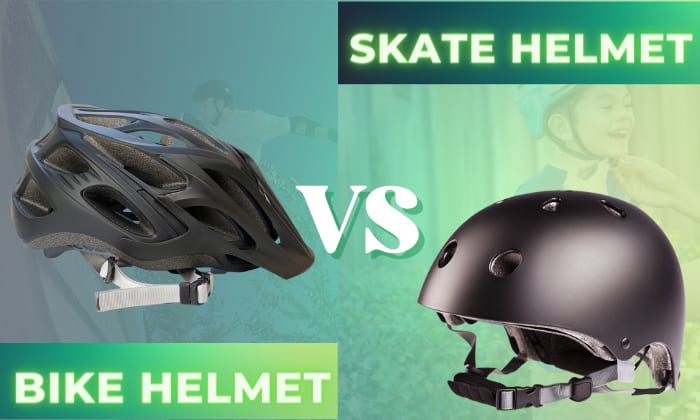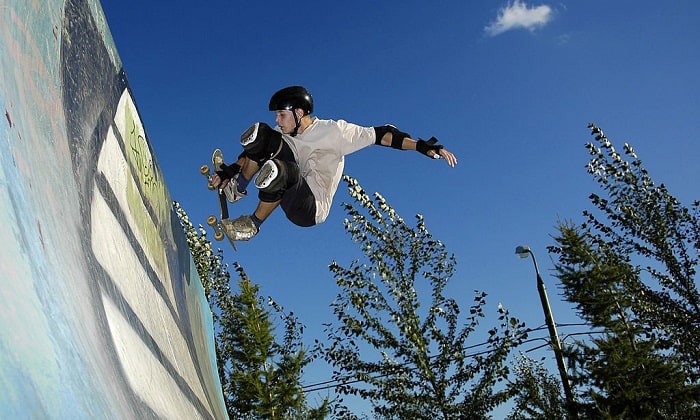If you’re an avid skateboarder, you might be confused about the difference between a bike helmet vs skate helmet, considering they are both safety equipment.
A novice cycling enthusiast may learn how to distinguish a proper helmet from one that’s low-quality, but other than that, it’s really difficult to differentiate two high-quality models made for different purposes – well, not without research or asking people on Reddit.
If you have this problem, check out this comparison of bike vs skate helmets.
| Features/
Characteristics |
Bike Helmet | Skate Helmet |
| Design | ● More aerodynamic | ● Less aerodynamic |
| Helmet Standard | ● Consumer Product Safety Commission (CPSC) Certification | ● American Society for Testing and Materials (ASTM) Certification
● Consumer Product Safety Commission (CPSC) Certification |
| Head Coverage | ● Downhill, Enduro, and Aggro BMX = Full Head Coverage
● BMX, Mountain bikes = Top and back of head ● Road & commuter = Top of head ● Trail = Top and (in some cases) rear coverage |
● Top and back of head |
| Impact Capacity | ● Single impact protection | ● Can withstand single or multiple impacts |
| Ventilation | ● Better ventilation | ● Limited ventilation |
| Padding | ● With foaming pads | |
| Visor | ● Some with visor | ● None |
| Outer shell | ● Lightweight | ● Sturdier and thicker outer shell |
Table of Contents
Skate Helmet vs Bike Helmet: What Are They?
A lot of people don’t consider a bike vs skate helmet to any different, but there are a few important disparities between them. It is not uncommon for many people to just go ahead and buy whatever helmet they see at a store that fits their budget.
This can be very unfortunate, since there are some things that you should consider before buying a bicycle helmet or a skateboarding helmet.
A Few Important Differences in Helmet Features
#1 Design
A suitable helmet for cycling is designed to be more aerodynamic than most skate helmets for traversing various terrains.
Since bike riding off-road or downhill will expose the helmet to ferocious winds, the design must reduce those impacts in order to ensure better vision and concentration while riding bikes.
#2 Safety Standards
Depending on their type and usage, both bike and skate helmets should fall under the regulations of the CPSC or ASTM.
A good biking helmet should meet CPSC standards if it’s in the U.S. You’ll also find CPSC skate helmet, with or without ASTM F1492 certification.
Skateboard headgear with only ASTM certificates (i.e, not dual certified) have a softer foam and should not be used during high-impact activities.
It’s worth noting that different countries have different helmet safety standards. For instance, UK helmets need to be meet EN1078 criteria by the British Standards Institution. It is the most common certification for cycling, skateboarding, and also roller skating helmets.
#3 Coverage
Skate helmets are designed to sturdily cover and protect the top up to the back of the head, since skaters commonly fall backward, especially when doing tricks.
On the other hand, a bike helmet’s coverage depends on the bike discipline. There are standard helmets that cover the top only, like road bike helmets.
Others cover the top and back of the head like what mountain bikers use, while full-face helmets with a visor and chin protector often appear in downhill riding.
#4 Impact Capacity
The interior foam on single-hit designs, most commonly used in bicycle helmets, protects the head through compression upon strike. Thus, these foams don’t return to their original shape after a collision strong enough to crack them.
However, a multi-impact feature, which is common on skateboard helmets, can withstand multiple impacts and extreme force before losing their protective capacity.
#5 Air Ventilation
Biking helmets, if you have noticed, have a lot of ventilation openings in comparison to skateboard helmets. This is to keep the rider’s head cool and well-ventilated, since bike riders tend to exert themselves more, especially during long trips under the summer sun.
A great bike helmet ventilation will then help in dissipating the heat on the rider’s head and the foam.
In fact, you may find cycling headgear with 24 vents, while skate style helmets often have 8 at best.
#6 Visor
Skate helmets today have no use for a visor accessory, since skaters can wear sunglasses, but some of the bike helmets– full-faced ones for mountain biking, for instance – are equipped with a visor to protect the visual field of the rider on rough terrain and in adverse weather.
#7 Outer Shell
Bike helmets shells are usually protected by a thin plastic called polycarbonate and are designed to be more lightweight to contribute to faster cycle speeds.
Skate helmets are also lightweight, but unlike bike helmets, they tend to be stiffer and sturdier for impact protection, thus dubbed as having a thick outer shell.
Pros and Cons
It is fun to ride your bicycle around or skate in the park leisurely. However, it is equally important not to skimp on safety gear. So, what are the pros and cons of wearing a helmet?
- Bike helmets offer cover and prevent concussions, skull fracture, and other head injuries. It can also protect you when falling face down on the ground.
- A helmet saves lives by reducing the risk of head injuries by 60% to 88%.
- Helps to keep your head warm in cold weather.
- They can be uncomfortable to wear at first, especially if your head is sensitive to pressure or touch.
- You also have to carry extra weight when wearing a helmet all day long.
- They are not invincible, even those that meet safety requirements.
Read more: 6 Steps to Wear a Bike Helmet Properly
Cost
Modern helmets come in many different styles and colors. Most bike helmets for kids and adults retail between $30 and $300. For example, a BMX helmet costs around $44 to $600, while a full head helmet (for downhill or enduro) costs around $60 up to a whopping $550.
There are helmets that are available in many sizes to fit different road cyclists and skaters, but most of the cheaply manufactured ones only have a one-size-fits-all characteristic.
You can buy a new helmet with a one-size design, but the quality and comfort are not guaranteed.
A skateboard hat helmet has a slightly similar price range, at least $25 to $200, but it is noticeable that this type is less expensive than bike helmets.
Although there are also cheaply manufactured designs available online that cost $11, it is still better to get the trusted and safest skateboard helmet you can find, especially if it’s a kids skateboard helmet.
If you want versatility, there are also brands like Thousand helmet that offer 2-in-1 models for urban biking and skating at $99.
Frequently Asked Questions
Why Is It Important To Choose The Right Helmet?
Many people purchase helmets without knowing which one is better or which type fits their activity best.
A helmet is a tool of protection, and thus its function is an important factor to consider when buying one.
A good-fitting helmet should sit comfortably on your head while providing ventilation and protection in case you get into an accident.
This is why it is also important to use a design specifically made for your discipline/sport.
That said, there is a multi sport helmet that is useful for multiple activities. A great example of this is the Snell N-94, which is proven to be up to standard and can be used for cycling and skating/skateboarding.
Can You Use A Skateboard Helmet To Ride A Bike?
Technically, you can use a skate helmet for cycling if it has a CPSC certification. Otherwise, skating helmets are not advisable substitutes for a bike helmet.
The same goes for the opposite situation. If you want to use a bike helmet for skateboarding, the gear you have in mind must be certified with both CPSC 1203 and ASTM F1492 standards before you can use it. Remember, skateboarding requires a stiffer helmet that can combat extreme force from crashes and falls.
What Factors Affect The Overall Quality Of A Helmet?
There are many factors that affect the overall quality of a helmet, be it a bicycle or even skateboard helmets. Some of these include the materials used to make the helmet, how it was designed and manufactured, and how much care it has been given during its lifetime.
A poorly designed helmet will not protect against head injuries quite as well as one that was made with all the proper features in mind. For instance, a high-quality model should have enough ventilation, adequate head coverage, a low weight, as well as additional safety components like liners, straps, and shells.
Vents on top of the helmet or the back will help with airflows when riding your bike so that you don’t get overheated.
Also, the size and shape of your head are major factors in determining the overall dimensions of your helmet. It would be useless to have skate and bike helmets if they won’t fit you properly.
Conclusion
There are many types of bike helmets and skate helmets available in the market, and confusion will get you if you are not well informed about them.
Today, we gained insight into the difference between a bike helmet vs skate helmet.
We compared them using some aspects like protection, design, and safety standards, which all riders need when picking their headgear.
Whether you’re cycling or skating, better get the correct helmet because helmets save lives.

“I ride my bike to work for years, but is that enough? Our carelessness towards our surroundings has taken a toll on the environment. And now, everyone is responsible for changes; even the most minor contribution is counted. With this hope and spirit, I started with my partner to establish Biketoworkday to help more individuals commute to their work sites on their bikes.”




